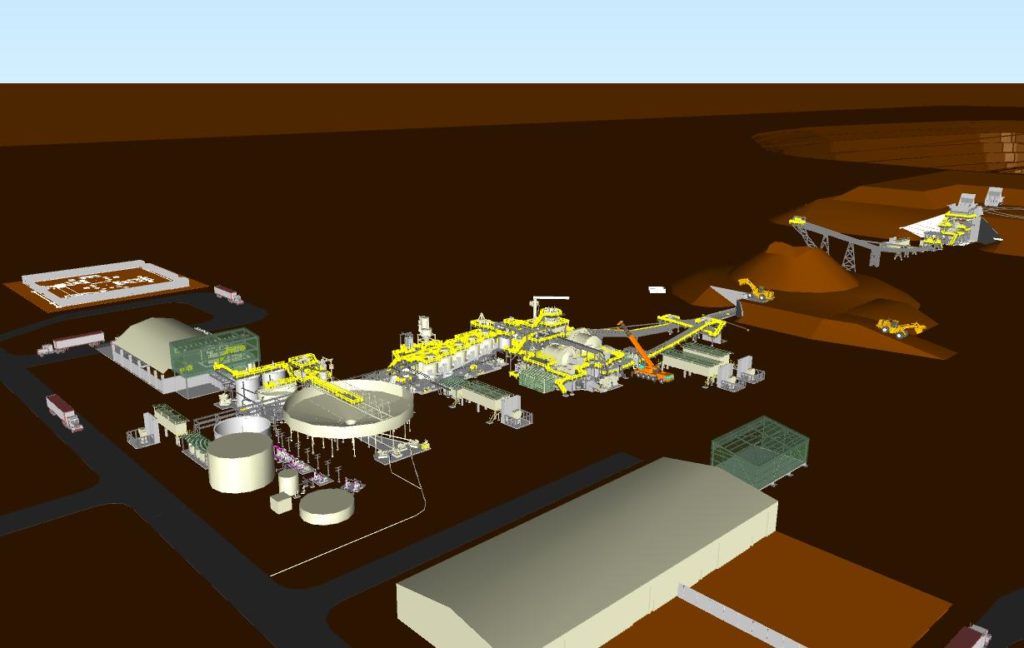The feasibility study for MOD Resources’ majority-owned T3 copper-silver open-pit project in Botswana has delivered compelling mine economics, in addition to a fleet and flowsheet plan that will interest the major mining original equipment manufacturers.
T3, in the Kalahari Copper Belt, is expected to require $182 million in development capital and deliver a mine able to produce life of mine average production of 28,000 t/y of copper concentrate and 1.1 Moz/y of silver at all-in sustaining costs of $1.56/Ib after deducting silver credits.
The pre-tax net present value (8% discount) for the project came in at $368 million based on a long-term copper price of $3.08/Ib, or $6,791/t.
The current plan would see T3 produce first product in the March quarter of 2021, operating over an 11.5-year mine life.
In terms of the primary loading fleet, the company said this would be made up of a maximum of five hydraulic excavators in the 120-250 t class. This is considered the optimal option that could achieve the required productivity, maintain a degree of selectivity when required and minimise the number of units required for practical separation of loading and hauling units, according to the company.
The ore and waste haulage fleet is expected to consist of 140 t mechanical drive haul trucks capable of direct tipping to the primary crusher.
MOD said there is step change to a lower annualised total material movement (TMM) after year five of operations. A peak TMM of 39 Mt (annualised) is due to be maintained during the first four years of the schedule, requiring 24 trucks and five excavators to ensured continuous ore supply. TMM drops to 6 Mt/y after year six and is generally maintained for the remaining life of mine, it said.
“The mining schedule has been constrained by setting a maximum vertical advance rate of 120 m/y annum to allow sufficient time for dewatering, grade control, drill and blast and load and haul,” the company said, adding that the maximum vertical lag between benches is set at 50 m.
The production schedule achieves the target process plant throughput rates both during ramp-up and during steady state operations of 3.0 Mt/y to 3.2 Mt/y (peak), it said.
The copper recovery plant and associated service facilities will process run of mine (ROM) ore delivered to a single stage primary crusher. The crushed ore will be stockpiled from where it is fed to a two-stage grinding circuit using SAG and ball milling. Copper minerals in the ground ore will be concentrated in a conventional copper flotation circuit, made up of roughing, regrind and a single stage of cleaning. Concentrate from the cleaning stage will be thickened then filtered on site prior to transporting to Walvis Bay, in Namibia. From Walvis Bay, the concentrate will be shipped to third-party smelters.
Tailing from the roughing and cleaning stages will be pumped to the tailings storage facility located south of the proposed mine. The TSF is designed to store approximately 34.4 Mt of conventional thickened tailing – enough for the 11.5 years of the project life.
The process plant is forecast to produce a life of mine annual average copper in concentrate of 28,000 t, with average grades for Cu and Ag of 30.4% and 383g/t, respectively.
The key criteria selected for the plant design are:
- The mill will process a total of 34.4 Mt of ROM ore for 11.5 years;
- The annual ROM treatment is 3.0 Mt/y with a peak treatment rate of 3.2 Mt/y, at a primary grind size of 80% passing 180 μm;
- Design availability of 91.5% with standby equipment in critical areas;
- Design copper head grade of 1.3%. This head grade allows for grade variation from the life-of-mine average grade of 1.0% Cu;
- Eighty-fifth percentile of comminution ore properties;
- Ore specific gravity of 2.8 t/m³;
- Laboratory rougher flotation residence of six minutes, and cleaner 1 and cleaner 1 scavenger residence time of two minutes and eight minutes, respectively, and;
- Rougher concentrate mass recovery of 6.2% (w/w) for regrind circuit sizing and final concentrate mass recovery of 3.6% (w/w) for thickener and filter sizing.











